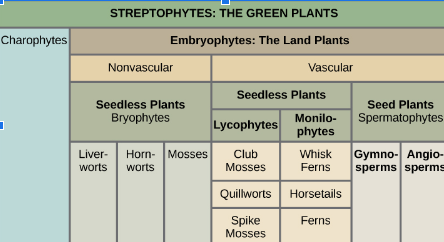LAb final review
1/35
There's no tags or description
Looks like no tags are added yet.
Name | Mastery | Learn | Test | Matching | Spaced |
|---|
No study sessions yet.
36 Terms
Characteristics of Protists: Cell Structure
A few protists live as colonies that behave in some ways as a group of free-living cells and in other ways as a multicellular organism. Some protists are composed of enormous, multinucleate, single cells that look like amorphous blobs of slime, or in other cases, like ferns. In some species of protists, the nuclei are different sizes and have distinct roles in protist cell function. Single protist cells range in size from less than a micrometer to three meters in length to hectares! Protist cells may be enveloped by animal-like cell membranes or plant-like cell walls. Others are encased in glassy silica-based shells or wound with pellicles of interlocking protein strips. The pellicle functions like a flexible coat of armor, preventing the protist from being torn or pierced without compromising its range of motion.
Characteristics of Protists: Metabolism
Exhibit many forms of nutrition & may be anaerobic or aerobic
Photoautotrophs (chloroplasts & phtosynthesis)
heterotrophic
phagocytosis: Amoebas and some other heterotrophic protist species ingest particles by a process in which the cell membrane engulfs a food particle and brings it inward, pinching off an intracellular membranous sac, or vesicle, called a food vacuole.
saprobes (decomposers)
mixotrophs: both photoautotrophic or heterotrophic depending on what foods are available
Characteristics of Protists: Motility
have one or more flagella, which they rotate or whip
Others are covered in rows or tufts of tiny cilia that they beat in a coordinated manner to swim
others form cytoplasmic extensions called pseudopodia anywhere on the cell, anchor the pseudopodia to a substrate, and pull themselves forward.
Some protists can move toward or away from a stimulus, a movement referred to as taxis.
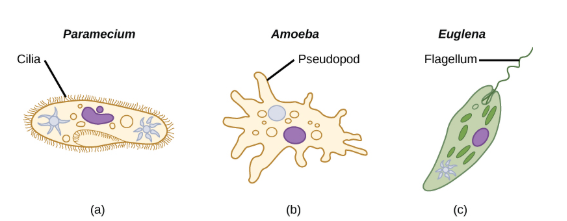
Characteristics of Protists: asexual reproduction
binary fission, to produce two daughter cells. In protists, binary fission can be divided into transverse or longitudinal, depending on the axis of orientation
multiple fission
budding: adult protists produce tiny buds that go on to divide and grow to the size of the parental protist.
Characteristics of Protists: sexual reproduction
meiosis and fertilization, is common among protists, and many protist species can switch from asexual to sexual reproduction when necessary. Sexual reproduction is often associated with periods when nutrients are depleted or environmental changes occur. Sexual reproduction may allow the protist to recombine genes and produce new variations of progeny, some of which may be better suited to surviving changes in a new or changing environment. However, sexual reproduction is often associated with resistant cysts that are a protective, resting stage. Depending on habitat of the species, the cysts may be particularly resistant to temperature extremes, desiccation, or low pH. This strategy allows certain protists to “wait out” stressors until their environment becomes more favorable for survival or until they are carried (such as by wind, water, or transport on a larger organism) to a different environment, because cysts exhibit virtually no cellular metabolism.
Characteristics of Protists: habitats
Nearly all protists exist in some type of aquatic environment, including freshwater and marine environments, damp soil, and even snow. Several protist species are parasites that infect animals or plants. A few protist species live on dead organisms or their wastes, and contribute to their decay.
Know the features of the fungi phylum and characteristics shared among organisms
Fungi, once considered plant-like organisms, are more closely related to animals than plants. Fungi are not capable of photosynthesis: they are heterotrophic (decomposers) because they use complex organic compounds as sources of energy and carbon. Fungi share a few other traits with animals. Their cell walls are composed of chitin, which is found in the exoskeletons of arthropods. Fungi produce a number of pigments, including melanin,also found in the hair and skin of animals. Like animals, fungi also store carbohydrates as glycogen. Some fungal organisms multiply only asexually, whereas others undergo both asexual reproduction and sexual reproduction with alternation of generations. Most fungi produce a large number of spores, which are haploid cells that can undergo mitosis to form multicellular, haploid individuals. Fungi often interact with other organisms, forming beneficial or mutualistic associations. Fungi also cause infections
because they lack lignin & vascular tissue, so they have no way to efficiently move water from their base to the rest of the plant
they are small and close to the ground in order to directly absorb water from the environmet into their cells
why are bryophytes small in size?


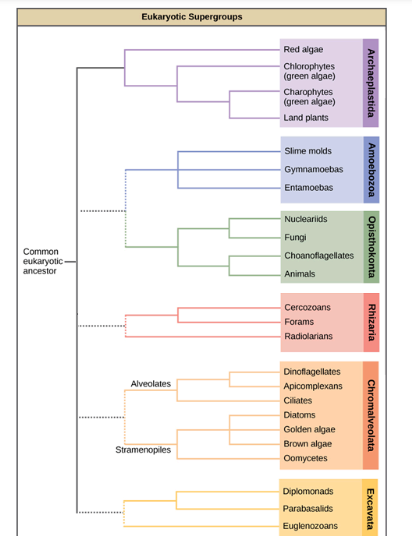
4 supergroups of protists
examples of each in the image
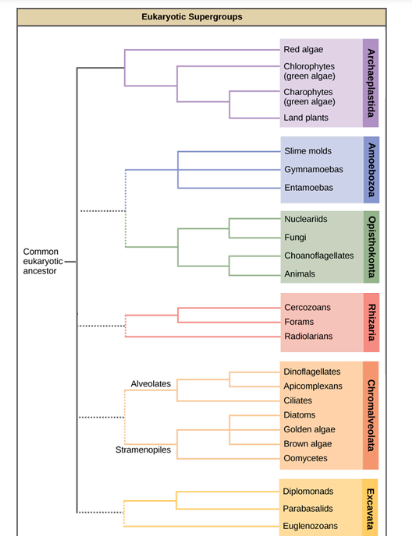
No, we did not evolve from chimpanzees we share a common ancestor. Both evolve separately. Humans did not evolve from chimpanzees ... We instead share a common ancestor that lived roughly 10 million years ago.
Did our ancestors evolve from chimpanzees?
1840s- 1850s
One of the most most famous early human fossils is the Neanderthal fossil discovered in the Neander Valley ( hence the name) in Germany in 1856
When was the first fossils of early humans found?
Humans and chimpanzees have been evolving independently for approximately 6-7 million years.
Using biomolecules, including DNA, researchers have estimated that modern humans and chimpanzees have been evolving independently for almost 7 million years
How long ago have humans and chimpanzees been evolving independently?
DNA comparison can provide insights into the timing of genetic changes associated with specific traits, including those unique to humans but they don’t directly reveal when physical characteristics like bipedalism evolved. Instead, scientists use comparative anatomy, and other archaeological findings to infer the timing of such evolutionary developments. For bipedalism, researchers analyze the skeletal remains of early hominins, track changes in the structure of the pelvis, spine, and limbs, and examine footprints and other evidence of locomotion found in ancient environments
Can DNA comparisons tell us when characteristics unique to humans such as bipedalism evolved? If not, what do we use instead?
yes
In 1974, Donald Johanson found a famous fossil in Ethiopia that was later named Lucy. Did this species use tools?
Molecular clocks
Fossil evidence
Most molecular clocks at the time, and many since put the split between humans and chimpanzees at only around 5-6 million years ago.
What was used to estimate when the ancestor of humans split from the ancestor of chimpanzees?
The story of humankind is reaching back another million years as scientists learn more about “Ardi,” a hominid who lived 4.4 million years ago in what is now Ethiopia. The 110-pound, 4-foot female roamed forests a million years before the famous Lucy, long studied as the earliest skeleton of a human ancestor.
Before Lucy, the famous Australopithecus afarensis specimen, there were several other genera of hominins. One notable genus that preceded Australopithecus afarensis is Ardipithecus. Ardipithecus species, such as Ardipithecus ramidus, lived around 4.4 million years ago and are considered among the earliest known hominins.
Ardipithecus ramidus
What Genus came before Lucy?
4.4 million years old
How old was this species?
A study of Ardi, underway since the first bones were discovered in 1994, indicates the species lived in the woodlands and could climb on all fours along tree branches, but the development of their arms and legs indicates they didn’t spend much time in the trees. And they could walk upright, on two legs, when on the ground.
Chat Gpt-Ardipithecus ramidus is believed to have displayed a mix of both bipedal and arboreal (tree-dwelling) adaptations. While it likely spent some time walking on two legs, its skeletal morphology also suggests adaptations for climbing and grasping, indicating that it was not fully committed to terrestrial bipedalism like later hominin species such as Australopithecus and Homo. Therefore, Ardipithecus ramidus is thought to have been capable of both bipedal walking and climbing.
Did this species only walk on two legs?
The fossils of Ardipithecus ramidus were discovered in the Afar Rift of Ethiopia. The habitat in this region during Ardipithecus’ time was likely a mix of woodlands, grasslands, and mosaic environments. The discovery of Ardipithecus fossils in this area provides evidence that bipedalism evolved in a wooded or woodland environment rather than in an open savanna, challenging earlier hypotheses that bipedalism evolved as a response to living in open grasslands
• In which habitat did this fossil show that bipedalism evolved?
angiosperms became the dominant form of plants because flowers enabled them to use insects for pollination and thus reproduce at a much faster rate
Why are angiosperms dominant compared to gymnosperms?
Eukaryotic
Multicellular (lack chloroplasts)
Heterotrophic
Motility for collection of food. Present at least during certain life stages of the animal
Diplontic/diploid
fixed body plan
6 characteristics of animals
invertebrates
category of animals that do not possess a cranium or vertebral column
vertebrates
members of the phylum Chordata that possess a backbone
radial symmetry
type of symmetry with multiple planes of symmetry, with body parts (rays) arranged around a central disk
bilateral symmetry
type of symmetry in which there is only one plane of symmetry, so the left and right halves of an animal are mirror images
phylum arthropoda
crab, spiders, insects
ecdysozoa
a is a collagenous/ chitinous cuticle that covers the body, and the necessity to molt the cuticle periodically during growth. , comprising nematodes, arthropods
deuterostomia
This phylum of animals has a calcareous endoskeleton composed of ossicles, or body plates. includes hemichordates, echinoderms, and chordates (vertebrate organisms belong to this group) Epidermal spines are attached to some ossicles and serve in a protective capacity. Echinoderms possess a watervascular system that serves both for respiration and for locomotion, although other respiratory structures such as papulae and respiratory trees are found in some species.
lophotrochrozoans
includes annelids, molluscs, bryozoans, brachiopods, platyhelminthes, and other animals that descended from the common ancestor of these organisms. Lophotrochozoa is one of the three major clades that comprise bilateral animals, or Bilateria.
phylum nematoda
roundworms, hookworms, pinworms
phylum annelida
polychaetes, earthworms, leeches
phylum mollusca
octupus, clams, snails, squid, oysters, jellyfish
examples of invertebrates
sea stars, sea urchins, earthworms, sponges, jellyfish, lobsters, crabs, insects, spiders, snails, clams, and squid.
protochordate
invertebrate animals that are closely related to vertebrates
They are generally found in marine water. Their body is bilaterally symmetrical, triploblastic, and coelomated. At a certain stage of their lives, their body develops a long, rod-like structure for support called the notochord.
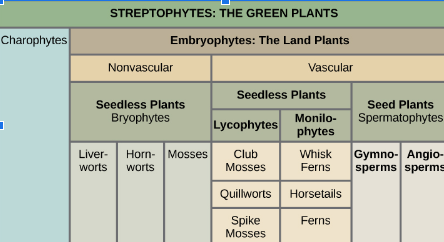
gnathostome
animals that possess jaws. Includes fishes & tetrapods
tetrapods: include amphibians, reptiles, birds, mammals
